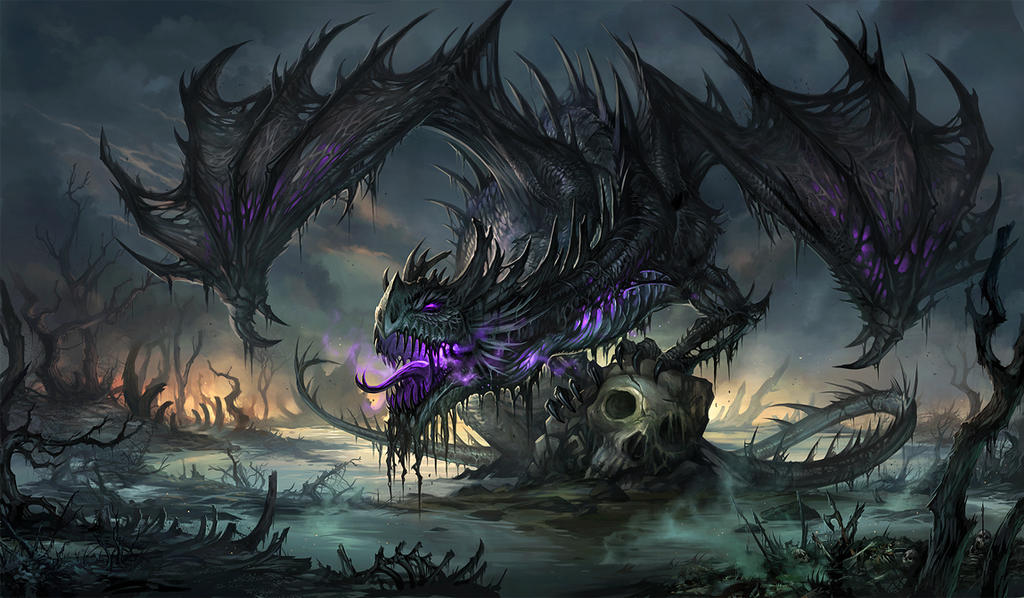Nidhogg (Old Norse Níðhöggr) is one of the most infamous of dragons in the Norse cosmos: even its own name is a curse.

The very first syllable of the dragon’s name – Nīþ – is a stigmatizing word, a social stigma in Norse and Germanic culture. It implies that a person has suffered a great loss of honor and is, in fact, a villain. It implies unmanliness, cowardice, villainy.
The insult of name someone a nīþ or nīðing, which is the person affected with the stigma of being a nīþ, also known as níðingr/ᚾᛁᚦᛁᚴᛦ in Old Norse, nīðing, nīðgæst in Old English, or nidding in Old Germanic) was a serious enough offence to legally allow for deadly duels – holmgangs, in order to defend one’s honor.
The insulted party was not only allowed to challenge the offender to a honor duel, but actually expected to.

Egill Skallagrímsson engaging in holmgang with Berg-Önundr, painting by Johannes Flintoe
Returning to the dragon, the dragon’s Nidhogg name literally means “Curse-striker” or “He Who Strikes with Malice”. He is the foremost of several serpents or dragons who dwell beneath the world-tree Yggdrasil and chew at its roots. This is highly injurious to the tree, which holds the Nine Worlds of the cosmos. Nidhogg’s actions have the intention of plunging the Nine Realms into chaos.
It is believed that Nidhogg will have a prominent role in Ragnarok, the downfall of the cosmos. In the Völuspá, one of the most important Norse poems, Nidhogg is described as flying out from beneath Yggdrasil during Ragnarok, presumably to aid the giants’ cause (The Poetic Edda. Völuspá, stanza 66).
From the Völuspá:
I there saw wadingthrough rivers wild
treacherous men
and murderers too,
And workers of ill
with the wives of men;
There Nithhogg sucked
the blood of the slain,
And the wolf tore men;
would you know yet more?
Later in the same poem, Nidhogg is also said to preside over a part of the underworld called Náströnd, “The Shore of Corpses”, where perjurers, murderers, and adulterers are punished.

This conception of reward or punishment in the afterlife must be taken with a giant grain of salt however, as it is clearly a Christian view from the author Snorri Sturluson. The very concept of moral retribution is totally foreign to the indigenous worldview of the Norse and other Germanic peoples, and must be an instance (one of many) of Christian influence upon the poem.
Leave your comments below!
Sources:
Lee M. Hollander (1962) The Poetic Edda. 15th. edition. Texas, USA: University Research Institute of the University of Texas. ISBN 978-0-292-76499-6
Simek, Rudolf. 2008. Dictionary of Northern Mythology. Translated by Angela Hall. BOYE6. ISBN-13 978-0859915137
Jesse Byock. 2005. Snorri Sturluson, The Prose Edda. 1st. edition. London, England: Penguin Books Ltd. ISBN-13 978-0-140-44755-2
Anthony Faulkes. 1995. Snorri Sturluson, Edda. 3rd. edition. London, England: Everyman J. M. Dent. ISBN-13 978-0-4608-7616-2
Daniel McCoy. 2016. The Viking Spirit: An Introduction to Norse Mythology and Religion. 1st edition. CreateSpace Independent Publishing Platform. ISBN-13 978-1533393036












